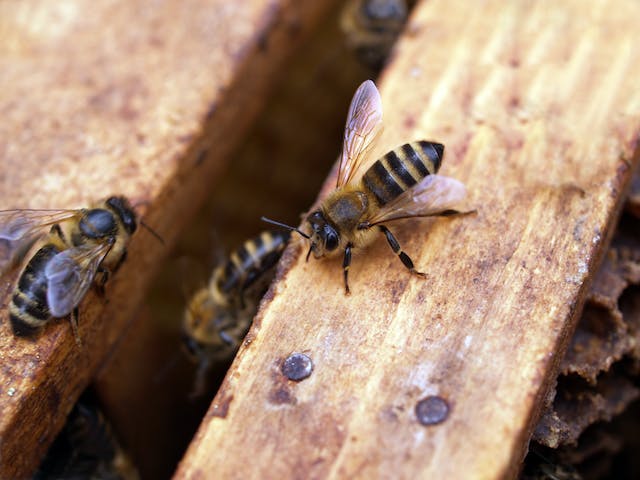
What is the difference between bees and wasps? There are many differences. Some of them are what they eat, where they live, how they sting, and how hairy they are. There are many more differences.
This is not an easy question because there isn’t just one type of bee and one type of wasp. There are 20,000 known species of bee in the world and there are huge differences between them. Some of them are no bigger than 2 mm, such as the Perdita minima, and some of them are over 4 cm long, such as Wallace’s giant bee. In the same way, there are over 100,000 species of wasp. The smallest is the dicopomorpha echmepterygis, which is only 0.127 mm long and the largest wasp is the Asian giant hornet which can get to over 5 cm. So, let’s just look at some general differences between the most commonly known bees and wasps.
The most common bees we see are the honeybees and the bumblebees. The most common wasps are the yellowjackets. They do have some similarities. They are both yellow and black, which is a warning to predators that the bees and the wasps carry venom. Many venomous animals employ this technique and they are usually red, yellow, black, or white, because these colors provide the most contrast with the greenery they live among. This way of showing the animal is not good for eating is called aposematism.
The diet of bees and wasps is the first difference. Bees feed on the nectar in flowering plants. This nectar is basically sugar and the bees feed on it and also carry it back to their hive to feed the larvae. This is what honey is made of. Wasps eat sugars, but they are also predators. Adult wasps feed on sugars and carbohydrates that they get from fruit, flower nectar, tree sap, and your jam donut, but their larvae need proteins. When the larvae are born, the adult wasps hunt down insects and other sources of protein, which they chew up and feed to the larvae. In return, the larvae use this protein for energy and secrete a sugary substance that the adult wasps can eat.
Their appearance is another difference. Wasps tend to be longer and thinner, while bees tend to be rounder. Bees are also covered in a fine layer of hair that makes them fuzzy. When they are feeding on the nectar from a flower, this fuzzy hair picks up pollen that they carry to another flower, thereby being an agent of pollination. Flowers and bees have both evolved in tangent. Bees have evolved to be more furry because they want to get more nectar and flowers have evolved to carry more nectar because they want bees to pollinate them. Wasps are not furry, although they are still pollinators. They are not as efficient as bees because they are smooth, but wasps are also pollinators of a lot of flowers. They are actually the sole pollinators of fig trees in a rather gruesome way. The fig trees release an aroma that attracts wasps when they are ready and the wasps crawl into the tiny flowers, losing their wings. They lay their eggs inside the flowers, pollinating the flower, and then die. The new wasps are born, chew their way out of the fig and fly to another flower to repeat the process. When they chew their way out of the fig, they get covered in pollen, which they carry to the new fig to pollinate it. The fig releases enzymes to digest the dead wasps. Interesting.
Their nests are different as well. Bee nests are made from wax. When they have found a good place to make their nest, the female worker bees cover the edge of the space with a thin layer of saliva, plant resin, and wax that they make. This substance is called propolis. This is kind of like a glue. The bees then continue to make the inside of the nest using wax that they secrete from under their abdomen. They chew this wax up and mold it into shape. Wasp nests are made from a kind of paper that is made by mixing chewed up wood particles with saliva.
Another difference is their stings. Many people know that when a bee stings, it’s stinger is barbed and so it gets ripped off the bee, leaving the bee to die later on. However, this is not all types of bees. Bumblebees don’t have a barbed stinger and they can happily sting you again and again, although they are not very aggressive. Wasps also don’t have a barbed stinger and can sting at will. There is an interesting reason why honeybees have a barbed stinger. The barb on the stinger allows the honeybee to be attached to whatever it is stinging for longer, injecting a larger dose of venom. Most of the time, honeybees are stinging insects, and their barbs don’t get stuck inside insects. They are able to sting and live to tell the tail. It is only with thicker skins, like ours, that the barb gets stuck and rips the stinger off the bee. They didn’t evolve to die stinging us, they evolved to be able to deliver a more lethal dose of venom to another insect. And this is what I learned today.
Photo by Johann Piber: https://www.pexels.com/photo/macro-shot-photography-of-black-and-yellow-bees-702935/
Sources
https://entomology.unl.edu/scilit/smallest-insect
https://en.wikipedia.org/wiki/Wasp
https://www.sydney.edu.au/news-opinion/news/2019/02/22/world-s-biggest-bee-found.html
https://www.usgs.gov/faqs/how-many-species-native-bees-are-united-states
https://en.wikipedia.org/wiki/Bee
https://www.renfrewshire.gov.uk/article/3990/The-difference-between-wasps-and-bees
https://www.pollinator.org/bees-vs-wasps
https://www.orkin.com/pests/stinging-pests/wasps/difference-between-bees-and-wasps
https://www.fs.usda.gov/wildflowers/pollinators/pollinator-of-the-month/fig_wasp.shtml
https://en.wikipedia.org/wiki/Yellowjacket
https://en.wikipedia.org/wiki/Honey_bee
https://en.wikipedia.org/wiki/Bumblebee
